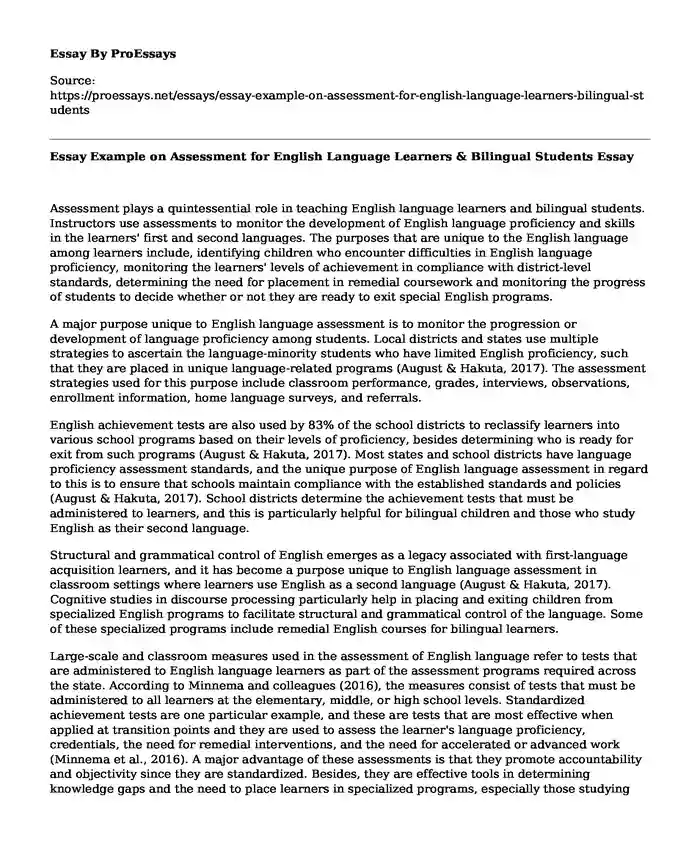Assessment plays a quintessential role in teaching English language learners and bilingual students. Instructors use assessments to monitor the development of English language proficiency and skills in the learners' first and second languages. The purposes that are unique to the English language among learners include, identifying children who encounter difficulties in English language proficiency, monitoring the learners' levels of achievement in compliance with district-level standards, determining the need for placement in remedial coursework and monitoring the progress of students to decide whether or not they are ready to exit special English programs.
A major purpose unique to English language assessment is to monitor the progression or development of language proficiency among students. Local districts and states use multiple strategies to ascertain the language-minority students who have limited English proficiency, such that they are placed in unique language-related programs (August & Hakuta, 2017). The assessment strategies used for this purpose include classroom performance, grades, interviews, observations, enrollment information, home language surveys, and referrals.
English achievement tests are also used by 83% of the school districts to reclassify learners into various school programs based on their levels of proficiency, besides determining who is ready for exit from such programs (August & Hakuta, 2017). Most states and school districts have language proficiency assessment standards, and the unique purpose of English language assessment in regard to this is to ensure that schools maintain compliance with the established standards and policies (August & Hakuta, 2017). School districts determine the achievement tests that must be administered to learners, and this is particularly helpful for bilingual children and those who study English as their second language.
Structural and grammatical control of English emerges as a legacy associated with first-language acquisition learners, and it has become a purpose unique to English language assessment in classroom settings where learners use English as a second language (August & Hakuta, 2017). Cognitive studies in discourse processing particularly help in placing and exiting children from specialized English programs to facilitate structural and grammatical control of the language. Some of these specialized programs include remedial English courses for bilingual learners.
Large-scale and classroom measures used in the assessment of English language refer to tests that are administered to English language learners as part of the assessment programs required across the state. According to Minnema and colleagues (2016), the measures consist of tests that must be administered to all learners at the elementary, middle, or high school levels. Standardized achievement tests are one particular example, and these are tests that are most effective when applied at transition points and they are used to assess the learner's language proficiency, credentials, the need for remedial interventions, and the need for accelerated or advanced work (Minnema et al., 2016). A major advantage of these assessments is that they promote accountability and objectivity since they are standardized. Besides, they are effective tools in determining knowledge gaps and the need to place learners in specialized programs, especially those studying English as their second language. As a downside, however, such assessments do not take into account the diverse needs of learners. Individuals who study English as a foreign language, for instance, maybe disadvantaged when using such assessment methods (Minnema et al., 2016). In my school, for instance, there is a single English Language learner, and she speaks Spanish. In her WIDA assessment, she needed translations in some of the units, and this affects her achievement levels in such tests, especially when using large-scale assessments.
Conclusion
In conclusion, there are multiple assessments whose purposes are unique to English language proficiency. Considering the diversity of learners and differences in learning speeds, the purposes of assessment in English include the need to place learners into specialized programs, particularly those with limited proficiency. It is also a means of meeting local district assessment standards, besides determining the eligibility for exit from specialized programs such as remedial school coursework.
References
August, D., & Hakuta, K. (2017). Improving schooling for language-minority children: A research agenda. National Academy Press, 2101 Constitution Avenue, NW, Washington, DC 20418
Minnema, J. E., Thurlow, M. L., VanGetson, G. R., & Jimenez, R. (2016). Large-Scale Assessments and English Language Learners with Disabilities: A Case Study of Participation, Performance, and Perceptions--"Walking the Talk!" ELLs with Disabilities Report 15. Retrieved from https://eric.ed.gov/?id=ED495898
Cite this page
Essay Example on Assessment for English Language Learners & Bilingual Students. (2023, Aug 30). Retrieved from https://proessays.net/essays/essay-example-on-assessment-for-english-language-learners-bilingual-students
If you are the original author of this essay and no longer wish to have it published on the ProEssays website, please click below to request its removal:
- Of Cats and Swimming
- Gaining Moral Resilience: Defining My Moral Compass - Essay Sample
- Essay on Communicative Competence: Hymes' (1972) Revolutionary Concept in English Language Teaching
- Essay Example on My Culture: Shaping My Behaviors & Adaptive Traits
- Essay Example on Critical Thinking: Activated Ignorance & Intellectual Autonomy
- Paper Example on The Attribution Theory: A Real-World Guide to Health Sector Performance
- Research Paper: The Role Culture Plays in Misunderstandings of Nonverbal Communication in the Classroom







